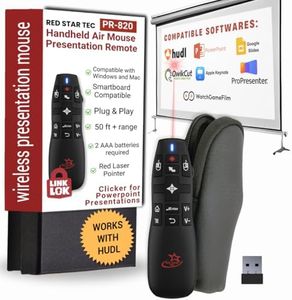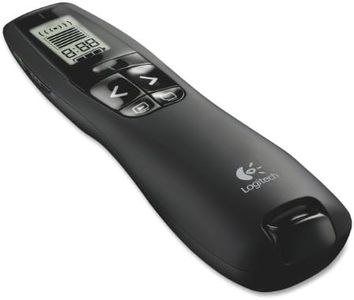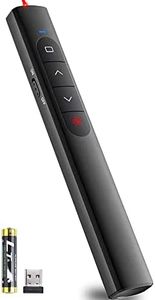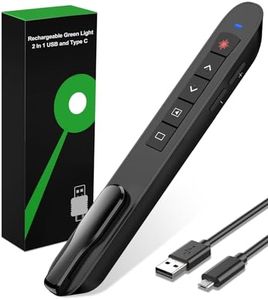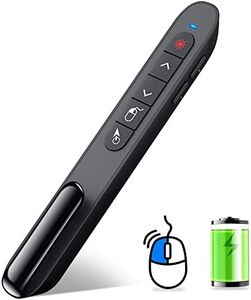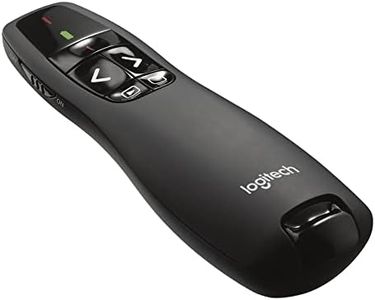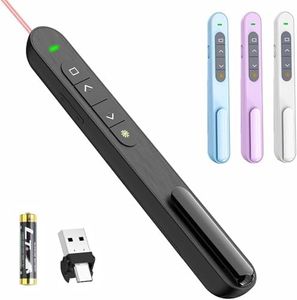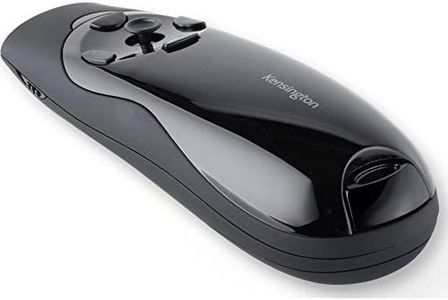We Use CookiesWe use cookies to enhance the security, performance,
functionality and for analytical and promotional activities. By continuing to browse this site you
are agreeing to our privacy policy
10 Best Presentation Remotes
From leading brands and best sellers available on the web.By clicking on a link to a third party's website, log data is shared with that third party.
Buying Guide for the Best Presentation Remotes
Choosing the right presentation remote can make your presentations smoother and more professional. The ideal remote will let you focus on your content without worrying about technology getting in your way. To make a good selection, it’s important to understand the main features and how they might relate to your needs, such as the size of the rooms where you present or the types of devices you connect to. Let’s look at the main specifications and how to approach them.Wireless RangeWireless range describes how far away you can be from your computer and still control your slides. This spec is important because it gives you flexibility to move around during your talk. Presentation remotes typically fall into short-range (up to 30 feet), medium-range (30–65 feet), and long-range (more than 65 feet) categories. If you only present in small meeting rooms, a short-range remote is usually enough. For large conference rooms or lecture halls, a medium or long-range option prevents the connection from dropping when you move around.
CompatibilityCompatibility tells you what kinds of computers or devices the remote can control, often via USB dongle, Bluetooth, or both. This is crucial because you want a remote that 'just works' with your hardware, whether it's a Windows, Mac, or even a tablet. Some remotes are plug-and-play with both operating systems, while others may be limited. If you regularly use different types of devices, pick a remote advertised as universally compatible for less hassle.
Control FeaturesControl features refer to what buttons and functions the remote provides besides simple slide advancing. Common features include next/previous slide, black screen, volume adjustment, and laser pointer. Advanced remotes might also offer mouse control or timer/vibration alerts. If you mostly need to move slides forward and back, a basic remote keeps things simple. If you like highlighting points with a pointer, select one with a laser or digital pointer. Teaching or leading complex workshops may call for more functions.
Battery Type and LifeBattery type and life cover whether the remote uses disposable batteries (like AAA) or has a built-in rechargeable battery, and how long you can use it before recharging or replacing batteries. Disposable batteries are easy to swap if they run out, while rechargeable remotes are more eco-friendly and convenient if you remember to charge them. If you travel or present often, look for a model with long battery life or an easily accessible battery compartment so you're not caught off guard.
Size and ErgonomicsSize and ergonomics refer to how the remote feels in your hand and its ease of use. Smaller remotes fit easily in your pocket but may be harder to operate if you have larger hands or prefer noticeable buttons. Larger, ergonomically-shaped remotes are comfortable for longer presentations. Try to picture yourself holding and using the remote—your comfort and preference should guide your choice here.
Laser Type and VisibilitySome remotes include a built-in laser pointer, which can be red or green. The laser type and brightness are important for visibility. Green lasers are easier to see on large screens or in bright rooms, while red lasers are standard and sufficient for smaller, darker rooms. If you often present in bright or large venues, a green laser may be worth considering.
Setup and StorageSetup and storage refer to how easy it is to start using the remote and store it when not in use. Some models are plug-and-play—you plug in the receiver and go—while others require software or pairing steps. Consider whether the remote includes a compartment for storing the USB receiver, which can prevent it from getting lost when traveling.



